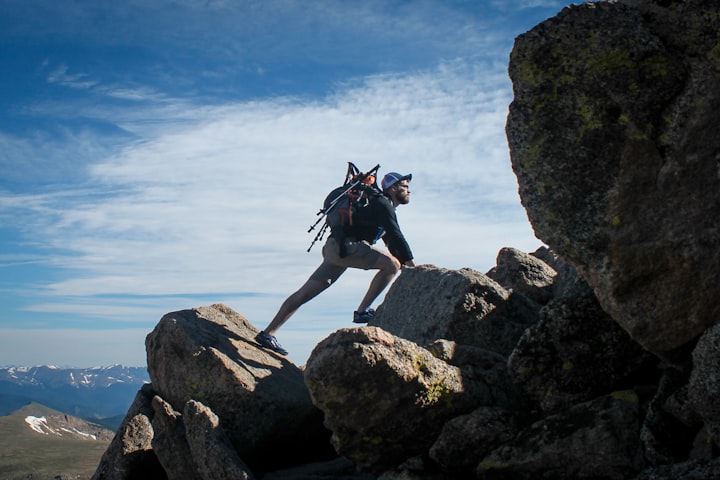Treading Lightly: Environmental Considerations in Ultralight Backpacking
While backpacking, in any form, is a way to connect with nature, it inevitably impacts the environment. From trail erosion and wildlife disturbance to the problem of litter, our presence in the wilderness leaves a mark.

Introduction
In recent years, ultralight backpacking has emerged as a popular trend among outdoor enthusiasts. Characterized by its minimalist approach, it involves carrying the lightest and simplest gear safely possible for a given trip. This growing movement not only challenges traditional backpacking norms but also opens up a dialogue about our environmental footprint in natural spaces.
While backpacking, in any form, is a way to connect with nature, it inevitably impacts the environment. From trail erosion and wildlife disturbance to the problem of litter, our presence in the wilderness leaves a mark. The ultralight philosophy, with its emphasis on carrying less, intuitively reduces some of these impacts, such as less wear on trails due to lighter packs. However, reducing weight should not compromise environmental responsibility.
This brings us to the importance of Leave No Trace principles, a set of guidelines designed to minimize outdoor activities' impact on the natural environment. While ultralight backpacking inherently carries some environmental advantages, it’s crucial for backpackers to consciously adopt these principles. The aim is to minimize our footprint, ensuring that the natural spaces we enjoy remain unspoiled for future generations. This article delves into understanding the environmental impact of backpacking and how integrating Leave No Trace principles with ultralight backpacking can create a more sustainable approach to exploring the great outdoors.
Understanding the Environmental Impact of Backpacking
Backpacking, while an enriching way to experience the natural world, comes with its own environmental footprint. Understanding this impact is the first step towards minimizing it.
Trail Erosion and Vegetation Damage
One of the most visible impacts of backpacking is trail erosion. As backpackers traverse paths, the repeated foot traffic can wear down trails, leading to soil erosion and loss of vegetation. In ultralight backpacking, where off-trail exploration is more feasible due to lighter packs, the risk of damaging untouched vegetation and habitats increases. It's important for backpackers to stick to established trails and camp at designated sites to minimize this impact.
Wildlife Disturbance
Our presence in the wilderness can significantly disturb local wildlife. The noise, movement, and even the scent of humans can alter the natural behavior of animals, leading to stress and disruption of their normal activities. In ultralight backpacking, the tendency to cover more ground and explore remote areas can increase these encounters. Maintaining a respectful distance from wildlife and avoiding areas known for high animal activity, especially during sensitive times like mating or nesting seasons, is crucial.
Water Source Contamination
Backpackers rely on natural water sources, and how they access and use these sources can impact the ecosystem. Contaminants from soaps, food, or even human waste can pollute waterways, affecting both the aquatic life and the quality of water for future visitors. Using biodegradable soaps, maintaining a safe distance from water sources while washing, and properly treating water before consumption are essential practices.
Litter and Waste Disposal
Littering, including improperly disposed-of food waste, is a significant issue in backpacking. Not only does it spoil the natural beauty of the environment, but it can also be harmful to wildlife. Ultralight backpacking emphasizes minimalism, which can reduce the amount of waste generated. However, it is vital to practice meticulous waste disposal, carrying out all trash, and adhering to guidelines for disposing of human waste.
Impact on Local Communities and Resources
Backpacking can also impact local communities and resources, especially in popular destinations. The influx of visitors can strain local infrastructure, lead to crowding, and affect the quality of life for residents. Being mindful of the local community, respecting regulations and customs, and supporting local economies can help mitigate these impacts.
In the next sections, we'll explore how integrating Leave No Trace principles with the ultralight backpacking philosophy can not only reduce these environmental impacts but also enhance the overall outdoor experience.
The Seven Principles of Leave No Trace
Integrating Leave No Trace (LNT) principles with ultralight backpacking is essential for minimizing environmental impact while enjoying the wilderness. These principles offer a guideline for responsible outdoor conduct, ensuring that our natural landscapes remain pristine for future generations.
1. Plan Ahead and Prepare
Proper planning is crucial to minimize your impact on the environment. This includes researching the area you'll be visiting, understanding the regulations and special concerns for the area, and preparing for extreme weather, hazards, and emergencies. In ultralight backpacking, efficient planning also means packing the lightest and most efficient gear to reduce your footprint.
2. Travel and Camp on Durable Surfaces
To protect fragile ecosystems, it’s important to travel and camp on durable surfaces. Stick to established trails and campsites. In areas without trails, avoid places where impacts are just beginning to show. Ultralight backpackers, often venturing into less-traveled areas, should be particularly mindful of this principle.
3. Dispose of Waste Properly
“Pack it in, pack it out” is a key mantra. All waste, including food scraps and packaging, should be carried out. Human waste should be disposed of properly, using restroom facilities where available or by burying it in a cathole at least 200 feet from water sources, trails, and campsites. Ultralight backpackers should also plan for lightweight, compact waste storage solutions.
4. Leave What You Find
Preserve the past and protect nature by not touching cultural or historical structures and artifacts. Leave rocks, plants, and other natural objects as you find them. Avoid introducing or transporting non-native species.
5. Minimize Campfire Impacts
Campfires can cause lasting impacts to the environment. Use a lightweight stove for cooking and enjoy a candle lantern for light. If you build a fire, do so in a designated fire ring or use a fire pan. Keep fires small and burn all wood to ash.
6. Respect Wildlife
Observe wildlife from a distance and do not follow or approach them. Never feed animals, as feeding wildlife damages their health and alters natural behaviors. Store your food and trash securely to avoid attracting wildlife.
7. Be Considerate of Other Visitors
Respect other visitors and protect the quality of their experience. Be courteous on the trail and in campsites. Avoid loud voices and noises, and let nature’s sounds prevail.
By adhering to these seven principles, ultralight backpackers can significantly reduce their environmental impact, ensuring that the trails and wilderness areas they cherish remain vibrant and unspoiled for years to come. In the next sections, we will explore how to integrate these principles into the ultralight philosophy for a harmonious and sustainable outdoor adventure.
Integrating Leave No Trace with Ultralight Backpacking
Ultralight backpacking and Leave No Trace principles complement each other in promoting minimal impact on the environment. The ethos of carrying only what is necessary in ultralight backpacking naturally aligns with LNT's emphasis on reducing our footprint. Here's how to integrate these practices seamlessly.
Minimalist Approach to Gear
In ultralight backpacking, every item in your pack should serve a purpose. Opt for gear that's lightweight but also durable and environmentally friendly. For instance, choosing a compact stove reduces the need for campfires, aligning with LNT's guidance on minimizing campfire impacts. Similarly, selecting biodegradable soaps and packaging-free food items helps in adhering to waste disposal principles.
Efficient Resource Use
Ultralight backpacking encourages efficient use of resources. This includes carrying a reusable water bottle with a built-in filter to avoid contaminating water sources, and using solar chargers instead of disposable batteries. These choices not only lighten your load but also minimize waste and environmental impact.
Advanced Planning and Preparation
A core principle of ultralight backpacking is meticulous planning, which coincides with the LNT principle of planning ahead. This involves understanding the specific LNT guidelines for the area you'll visit, preparing for weather conditions, and knowing your physical and skill limits. Thorough planning ensures that you carry exactly what you need, avoiding overpacking and the associated strain on the environment.
Responsible Waste Management
Ultralight doesn’t mean cutting corners on waste management. Use lightweight, resealable bags to pack out trash, and consider a compact, portable toilet system for areas where burying human waste isn't appropriate. This aligns with LNT's principles of disposing of waste properly and leaving what you find.
Wildlife Protection
The mobility afforded by ultralight backpacking means you may venture into more remote, wildlife-rich areas. Equip yourself with knowledge about local wildlife and practice viewing them from a distance. Store food in bear-proof containers or hang it properly to prevent wildlife encounters.
Ethical Interaction with the Environment
Ultralight backpacking should enhance your connection with nature, not detract from it. This means staying on designated trails, camping on durable surfaces, and avoiding activities that could damage the environment. Use a map and compass or GPS to navigate without marking or altering the landscape.
Respectful Coexistence with Fellow Travelers
Finally, the solitude often sought in ultralight backpacking should not come at the expense of others’ experiences. Respect trail etiquette, such as yielding to uphill hikers, and maintain a low profile by keeping noise levels down.
By incorporating these strategies, ultralight backpackers can fully embrace Leave No Trace principles, ensuring their adventures are sustainable and respectful of the natural world. Next, we'll address common challenges and misconceptions about practicing Leave No Trace in an ultralight context and provide solutions and alternatives to these challenges.
Challenges and Common Misconceptions
While integrating Leave No Trace (LNT) principles with ultralight backpacking is ideal for minimizing environmental impact, there are challenges and misconceptions that can hinder this practice. Addressing these head-on can help backpackers make more informed decisions and uphold the integrity of the wilderness.
Misconception: Lighter Always Means More Sustainable
A common misconception is that the lighter your backpack, the more sustainable your hike. However, this isn’t always true. Ultralight gear can sometimes be less durable, leading to a need for frequent replacements and, consequently, more waste. It's essential to strike a balance between weight and durability, choosing gear that's light but can withstand repeated use.
Challenge: Limited Access to Ultralight, Eco-Friendly Gear
Finding gear that is both ultralight and environmentally friendly can be challenging. Many ultralight products focus primarily on weight reduction, sometimes at the cost of sustainability. Backpackers may need to research and invest more to find products that meet both criteria.
Misconception: Smaller Pack, Smaller Impact
There’s a notion that a smaller pack automatically equates to a smaller environmental footprint. However, the impact depends more on the behavior of the backpacker than on the size of their pack. Practicing responsible trail and campsite usage is crucial regardless of how much you carry.
Challenge: Adhering to LNT in Remote Areas
Ultralight backpacking often involves exploring remote areas where LNT practices can be more challenging to implement, especially in terms of waste disposal and campsite selection. Backpackers may need to be more creative and disciplined in such environments, planning extensively to adhere to LNT principles.
Misconception: Ultralight Backpacking is Less Impactful by Default
While ultralight backpacking reduces certain types of impact, like soil erosion from lighter packs, it doesn't automatically reduce all types of environmental impact. Every backpacking trip, regardless of style, has the potential to impact nature, and LNT principles are essential in mitigating this.
Challenge: Overcoming the Learning Curve
There’s a learning curve to effectively combining ultralight backpacking with LNT principles. New ultralight backpackers might struggle to find the right balance between carrying less and being prepared to minimize their impact. Continuous learning and experience are key to overcoming this.
Misconception: Leave No Trace is Too Restrictive
Some believe that LNT principles are too restrictive and can diminish the enjoyment of backpacking. However, these principles are designed to enhance, not hinder, the outdoor experience by preserving the natural beauty and integrity of wilderness areas.
Addressing these challenges and misconceptions is crucial for ultralight backpackers. By understanding the nuances and adopting a balanced approach, backpackers can enjoy their adventures responsibly, ensuring that the trails and natural spaces they love remain unspoiled. In the conclusion, we will reinforce the importance of these practices and encourage a commitment to sustainable backpacking.
Conclusion
As we navigate the trails and embrace the wilderness through ultralight backpacking, the responsibility of protecting and preserving our natural environments becomes paramount. Integrating Leave No Trace principles into the ultralight philosophy isn't just a choice—it's an essential commitment to the future of our planet's wild spaces.
The core message of Leave No Trace is simple yet profound: enjoy the natural world, but leave it undisturbed for others to enjoy as well. This ethos aligns perfectly with the minimalist spirit of ultralight backpacking, where every ounce saved is a step towards a deeper respect for nature. By planning carefully, choosing sustainable gear, and practicing ethical wilderness habits, we can significantly reduce our environmental impact.
It's important to remember that Leave No Trace principles are not just rules to follow but a mindset to embrace—one that values stewardship and mindfulness. They remind us that we are visitors in the natural world, a world that demands our respect and care.
As we conclude, let's carry forward the lessons and insights gained from our exploration of Leave No Trace and ultralight backpacking. Let us commit to being conscientious backpackers who tread lightly on the earth, leaving no trace of our passage except for memories and a lasting appreciation for the beauty and fragility of our natural world.
Our journey through the wilderness is more than a physical challenge; it's a chance to connect with nature and learn from it. By embracing the adaptive cycle of growth and change, not just in our backpacking endeavors but in our approach to environmental stewardship, we become part of a community dedicated to preserving the wilderness for future generations.
So, as we pack our bags and set out on our next adventure, let's do so with a renewed commitment to sustainability, responsibility, and a deep respect for the natural world. Let's continue to learn, adapt, and grow as ultralight backpackers and stewards of the planet, ensuring that the trails we love remain vibrant and unspoiled for years to come.




